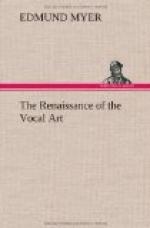The tendency with beginners and with those who have formed wrong habits of breathing, is to take a voluntary breath before coming into action. This of course defeats the whole thing. Again, the tendency of beginners or of those who have formed wrong habits, is to sing before finding the level of the tone through the movements, or to start the tone before the action. This of course compels local effort and contraction, and makes success impossible. The singer must have breath; and if he does not get it automatically through the flexible movements herein described, or some such movements, he is compelled to take it consciously and locally. The conscious local breath in singing is always an artificial breath, and compels local control. Under these conditions ease and perfect freedom are impossible.
As we have said, the important thing to consider in this study is the movement from repose to the level of the first tone. Move in a free, flexible manner as before described, and give no thought to breath-taking. When you have found the level of the tone, all of which is done rhythmically and in a moment, let the voice sing,—sing spontaneously. Make no effort to hold or control the breath. Maintain correct position the level of the tone, in a free, flexible manner, and sing with perfect freedom, with abandon. As the movement or action gave you the breath, so will the position hold it. The more you let go all contraction of body and throat muscles, the more freedom you give the voice, the more will the breath be controlled,—controlled through automatic form and adjustment. This is a wonderful revelation to many who have tried it and mastered it. Those who have constantly thought in the old way, and attempted to breathe and control in the old way, cannot of course understand it. The tendency of such is to condemn it,—to condemn it, we are sorry to say, without investigation.
Knowledge is gained through experience. The singer or pupil who tries this system of breathing and succeeds, needs no argument to convince him that it is true, natural and correct. The greatest drawback to the mastering of it on the part of many singers and teachers, is the artificial habits acquired by years of wrong thinking and wrong effort. With the beginner it is the simplest, the easiest, and the most quickly acquired of all systems of breathing; for automatic breathing is a fundamental, natural law of artistic singing.
For further illustration of this principle of breathing we will use the following exercise:
[Illustration: FOURTH STUDY. Ah....]
Place yourself in a free, flexible manner on a level with the first tone. If this is done properly, you will have secured automatically a singing breath and all true conditions of tone. When singing this exercise move the hands and body with the tone or voice, ascending and descending. In ascending open freely and naturally by letting go. Do not influence the form by attempting locally to open.




